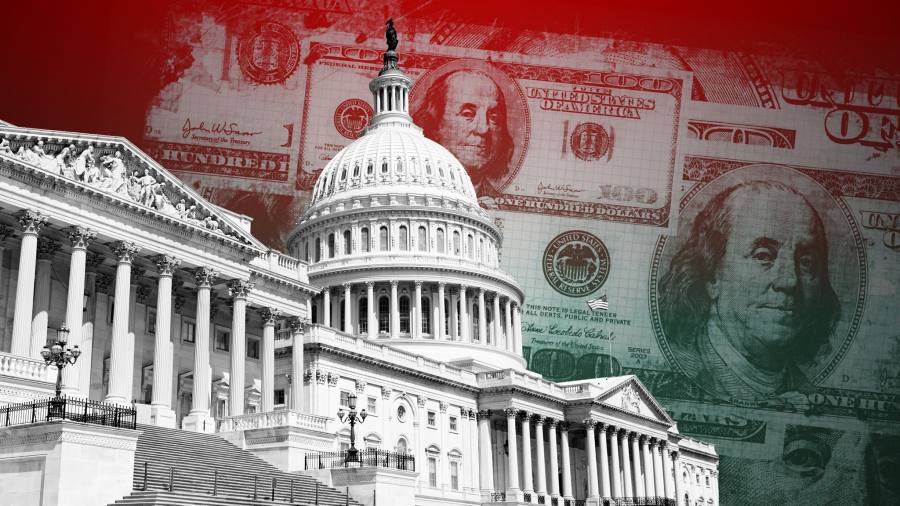Are mainstream investors ready for disaster? With the clock ticking close to a US government debt default described by Treasury secretary Janet Yellen as an “unthinkable” move with “dreadful consequences”, we could be about to find out.
For specialist hedge fund managers who make money only in the event of calamities such as financial crises and pandemics, bracing for the worst is pretty easy: just keep picking up options and other instruments on the cheap that provide a hedge against sudden price falls. Then when the nightmare scenario strikes, count your billions and slap on your best suit to go on Bloomberg TV and say you take no pleasure in everyone else’s pain.
More typical fund managers who cannot afford to make money just once a decade have a trickier task.
On the face of it, they are ready for the small chance that the market underpinning every asset value on earth is about to backfire. Prices for US credit default swaps — derivatives that provide a kind of insurance against non-payment of debt — have picked up markedly albeit with only tiny volumes changing hands compared with the vast size of the market. That means some investors, most likely hedge funds and especially those that thrive on disaster, have placed low-cost, high-reward bets on a market meltdown. But even this market is not looking panicky, as such.
Meanwhile, a glance at the US stock market would not suggest anything is amiss. The benchmark US equities index the S&P 500 has been going nowhere since the end of March. You can make the case it should be higher, given the continuing slowdown in inflation, so maybe the debt ceiling cliff edge is holding it back. Maybe.
Still, this is not a market that looks like it could be just three weeks or so away from a government debt default. It is a serious possibility, though; Unless Congress raises or somehow redefines the US debt limit sharpish, the federal government will find itself unable to make a range of payments including to holders of its debt, potentially as soon as early June.
It is hard to overstate how much of a problem this would be for markets. If Treasuries fail, then stocks, bonds and everything in between will convulse in violent ways that are hard to predict. The desperate dash for cash in March 2020 and the UK gilts crisis of 2022 are just two reminders of how sudden market shocks can turn ugly, quickly.

The relative calm now stems from several sources. One is that analysts and investors broadly believe cool heads will prevail. Congress will do a deal or find some kind of fudge or gimmick to avert a horror show, just as it did the last time this issue really flared up in 2011 and just as it has done 78 times since 1960. Fund managers feel like they have seen this movie before and it always ends OK.
This time it is dangerous to assume politicians will find a compromise. As political analyst Tina Fordham points out, a tendency towards calm, sensible problem-solving is not exactly a prized asset for Congressional members these days. She thinks there is a roughly 20 per cent chance of a US debt default in the coming weeks. “Twenty per cent probability events happen all the time,” she said on CNBC this week.
The other reason this is not yet really hurting stocks is that, just as it is not possible to be a little bit pregnant, “it is hard to price in a little bit of default”, say rates analysts Richard McGuire and Lyn Graham-Taylor at Rabobank. “Hence, CDS and short-dated Treasury bills are reflective of heightened hedging demand while equities . . . appear somewhat insulated as the game of brinkmanship is played out.”
Rabobank’s analysts are with the crowd on this: “Our base case is that a default will be avoided.” Even so, they point to the other big danger, which is that for the politicians involved, the chaos itself is an important part of the process.
“It is in the interests of both parties to appear willing to countenance [a default] for as long as possible, as this maximises the likelihood of extracting concessions should the other side blink first,” they said. “[That] does raise a clear risk that the market’s apparent broader sanguinity on this front will be tested in the coming weeks.”
This is a view shared by Sushil Wadhwani, chief investment officer at PGIM Wadhwani. In a note this week, he said that “in an increasingly polarised environment, politicians will need to see significant market turbulence in order to reach an agreement”.
Investors are conditioned to believe that in the event of some kind of downturn in markets, stocks will quickly push back up. As Wadhwani pointed out, that is unhelpful. “There is a concern that the market is being complacent and that investors could be in for a sudden shock,” he said. “Investors would not want to see unexpected fiscal tightening at a time when the risks of US recession are already rising and the possibility of a hard landing is increasing.”
If you are trundling along assuming this will all work out just fine, you’re possibly in the same camp as Donald Trump, who thinks “it could be really bad, it could be maybe nothing, maybe it’s a bad week, or a bad day, who knows?” That may help focus the mind.
katie.martin@ft.com


